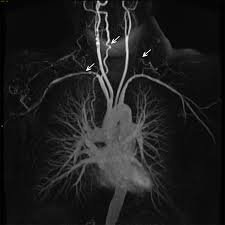2.6 cases of Takayasu Arteritis per million, per year, have been reported. It is 10 times common in females

Mumbai: A team led by Dr. Ravi Gupta, Cardiologist, Wockhardt Hospital, Mumbai Central, successfully treated a 28-year-old Kenyan woman with Takayasu Arteritis who complained of uncontrolled hypertension and giddiness. After treatment, the patient is back on track now and has resumed her daily activities.
Halima Salad, who is a resident of Kenya, would feel giddy, abdomen pain, weakness in the left hand, bilateral renal arteries blockages, both side 95 percent each. So, her blood pressure was very high despite four medicines for blood pressure. It was 200/120 mmHg. This kept her away from her daily activities. On consulting various medicos in Kenya, it was revealed that Halima suffered from Takayasu arteritis and had multiple blockages throughout the body. Owing to the lack of expertise and medical facilities in Kenya, she was referred to Wockhardt Hospital, Mumbai Central, was Dr. Ravi Gupta gave her a new way of life.
Dr. Ravi Gupta, Cardiologist, Wockhardt Hospital, Mumbai Central, said, “Takayasu arteritis can be described as an uncommon vasculitis, which is a group of disorders causing inflammation of the blood vessels with unknown causes. The inflammation tends to damage the aorta that is the large artery carrying blood from your heart to other parts of the body. Moreover, it can lead to blocked arteries, chest and arm pain and high blood pressure.”
He added, “2.6 cases of Takayasu Arteritis per million, per year, has been reported. It is 10 times common in females. This patient required immediate treatment as there were multiple blockages of the arteries of both kidneys, left leg and abdominal pain. Ignorance could have led to brain hemorrhage. She had blocked the left subclavian artery, which supplies the left upper limb, there was no pulse on her left hand, which became normal after angioplasty. After renal angioplasty, the blood pressure controlled dramatically and was 130/80 on no medicines. She had pain in the abdomen after meals, which is known as abdominal angina due to the blocked superior epigastric artery and coeliac trunk, which supply the gut. These were also undergone angioplasties. Whenever we see high blood pressure in young people, almost 5 % have some reversible cause, and the kidney artery blockage is one of those regions. So, if you suffer from uncontrolled hypertension or giddiness then immediately consult your doctor.”
Patient Halima Salad said, “I couldn’t do my daily chores with ease as my blood pressure would be high, and would feel giddy all the time. But, after taking treatment at Wockhardt Hospital, I feel better now. I thank the doctors for helping me to tackle Takayasu Arteritis and save my life. I urge people to seek timely intervention, and stay hale and hearty!”















































